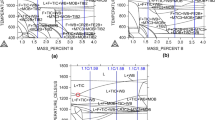Conclusions
-
1.
In tempering of 34KhN1M steel, types M7C3 and M23C6 carbide are formed.
-
2.
A reduction in carbon content in the steel causes an increase in the rate of the carbide reactions M3C→M7C3 and M3C→M23C6.
-
3.
There is a correlation between the hardness of 34KhN1M steel and the degree of development of the M3C→M7C3 carbide reaction. With development of carbide transformation a reduction in hardness of the steel is observed.
Similar content being viewed by others
Literature cited
N. F. Lashko, L. V. Zaslavskaya, M. N. Kozlova, et al., Physicochemical Phase Analysis of Steels and Alloys [in Russian], Metallurgiya, Moscow (1978).
M. E. Blanter, The Theory of Heat Treatment [in Russian], Metallurgiya, Moscow (1984).
N. Bandyopad, C. L. Briant, and E. L. Hall, "Carbide precipitation, iron boundary segregation, and temper embrittlement in Ni−Cr−Mo−V rotor steels," Metall. Trans., 6A, No. 5, 721–737 (1985).
M. I. Gol'dshtein and V. M. Farber, Dispersion Hardening of Steel [in Russian], Metallurgiya, Moscow (1979).
Additional information
Central Scientific-Research, Design, and Construction Institute for Boilers and Turbines, Scientific and Production Union. Translated from Metallovedenie i Termicheskaya Obrabotka Metallov, No. 1, pp. 19–21, January, 1991.
Rights and permissions
About this article
Cite this article
Pigrova, G.D., Korkka, S.I. Formation of carbide phases in 34KhN1M steel during tempering at 550–700°C. Met Sci Heat Treat 33, 31–35 (1991). https://doi.org/10.1007/BF00775031
Issue Date:
DOI: https://doi.org/10.1007/BF00775031




